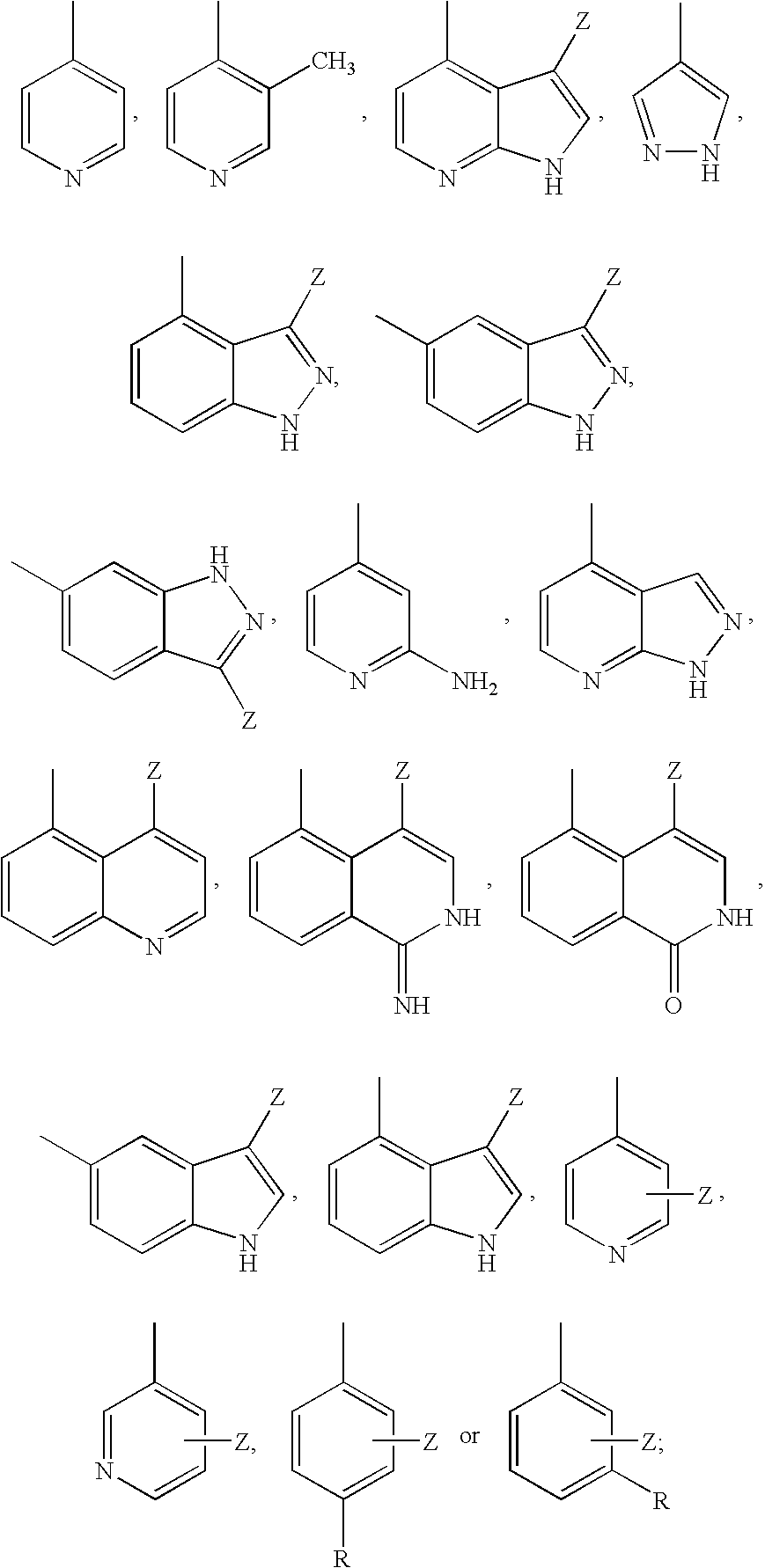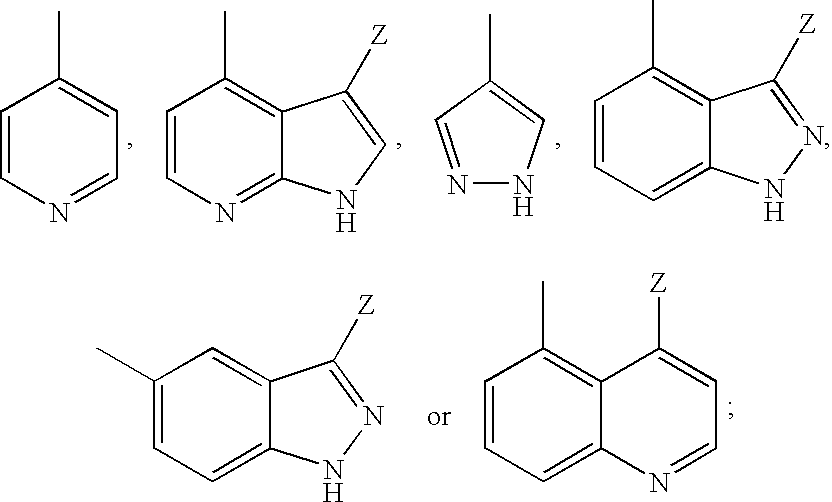Aminopyrazine analogs for treating glaucoma and other rho kinase-mediated diseases and conditions
- Summary
- Abstract
- Description
- Claims
- Application Information
AI Technical Summary
Benefits of technology
Problems solved by technology
Method used
Image
Examples
specific examples
Example 1
3-(4-Methyl-1,4-diazepan-1-yl)-5-(Pyridin-4-yl)pyrazin-2-amine
[0071]
[0072] Step A: 5-Bromo-3 -(4-methyl-1,4-diazepan-1-yl)pyrazin-2-amine Prepared from commercially available 2-amino-3,5-dibromopyrazine and 1-methylhomopiperazine according to general procedure 4 (method 1) providing the diaminopyrazine (204 mg, 90%) as a dark oil; 1H NMR (500 MHz, CDCl3) δ 7.65 (s, 1H), 4.49 (br s, 2H), 3.51-3.48 (m, 4H), 2.74-2.73 (m, 2H), 2.71-2.67 (m, 2H), 2.41 (s, 3H), 2.00-1.93 (m, 2H); ES-MS: (M+H)=286, 288 m / z.
[0073] Step B: Prepared from the product of Step A and 4-pyridylboronic acid according to general procedure 6 (method 1). Purification by column chromatography (12 g ISCO column eluting with methylene chloride and a 10:1 methanol / ammonium hydroxide mixture; gradient 100% methylene chloride to 95% then 90% and finally 85% methylene chloride) provided the title compound (123 mg, 62%) as a light green solid; 1H NMR (500 MHz, CDCl3) δ 8.63-8.62 (d, J=5.4 Hz, 2H), 8.17 (s, 1H), 7...
example 2
3-(4-Methyl-1,4-diazepan-1-yl)-5-(3-methylpyridin-4-yl)pyrazin-2-amine hydrochloride
[0074]
[0075] Prepared from the product of Step A in example 1 and 3-methyl-4-pyridylboronic acid under similar conditions. Purification by column chromatography (12 g ISCO column eluting with methylene chloride and methanol / ammonia mixture (10:1); gradient 100% methylene chloride to 80% methylene chloride over 30 min at 25 mL / min) followed by conversion to the hydrochloride salt with 2N HCl in diethyl ether provided the title compound (41 mg, 34%) as brown solid; 1H NMR (500 MHz, CD3OD) δ 8.51 (s, 1H), 8.47-8.46 (d, J=5.4 Hz, 1H), 8.07 (s, 1H), 7.76-7.75 (d, J=5.5 Hz, 1H), 3.78-3.76 (t, J=4.7 Hz, 2H), 3.55 (br s, 6H), 2.97 (s, 3H), 2.55 (s, 3H), 2.28-2.23 (qui, J=5.9 Hz, 2H); 13C NMR (125 MHz, CD3OD) δ 150.2, 149.7, 149.2, 146.8, 145.0, 137.9, 137.8, 134.1, 125.2, 58.1, 57.0, 50.6, 47.1, 45.1, 26.1, 18.6; HPLC tR=7.2 min, >99%; ES-MS: (M+H)=299 m / z.
example 3
3-(4-Methyl-1,4-diazepan-1-yl)-5-(1H-pyrazol-3-yl)pyrazin-2-amine
[0076]
[0077] Step A: 4-(4,4,5,5-Tetramethyl-1,3,2-dioxaborolan-2-yl)-1-((2-(trimethylsilyl)ethoxy)methyl)-1H-pyrazole 4-(4,4,5,5-Tetramethyl-1,3,2-dioxaborolan-2-yl)-1H-pyrazole (348 mg, 1.8 mmol) was dissolved in DMF (5 mL) and sodium hydride (60% dispersion, 86 mg, 2.15 mmol) added. The mixture heated to 60° C. for 5 min. Upon cooling and stirring for an additional 15 min, trimethylsilylethoxymethyl chloride (358 mg, 2.15 mmol, 381 μL) was added dropwise over 5 min and mixture stirred for 16 h. The reaction mixture was diluted with ethyl acetate (25 mL), washed with 5% lithium chloride (5×), dried over sodium sulfate and concentrated. The residue was purified by column chromatography (40 g ISCO column eluting with hexanes and ethyl acetate; gradient 100% hexanes to 50% hexanes over 30 min at 30 mL / min) to provide the SEM-protected pyrazole (360 mg, 61%) as a colorless oil; 1H NMR (500 MHz, CDCl3) δ 7.84 (s, 1H), 7.8...
PUM
| Property | Measurement | Unit |
|---|---|---|
| Fraction | aaaaa | aaaaa |
| Fraction | aaaaa | aaaaa |
| Fraction | aaaaa | aaaaa |
Abstract
Description
Claims
Application Information
 Login to View More
Login to View More - R&D
- Intellectual Property
- Life Sciences
- Materials
- Tech Scout
- Unparalleled Data Quality
- Higher Quality Content
- 60% Fewer Hallucinations
Browse by: Latest US Patents, China's latest patents, Technical Efficacy Thesaurus, Application Domain, Technology Topic, Popular Technical Reports.
© 2025 PatSnap. All rights reserved.Legal|Privacy policy|Modern Slavery Act Transparency Statement|Sitemap|About US| Contact US: help@patsnap.com



